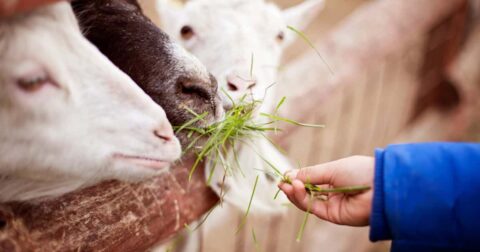Feature
Heat Exhaustion, Amputated Fingers, Crushed Limbs: The Hidden Cost of American Turkey
Food•8 min read
Analysis
When a 9-year-old tried to pull her goat from auction, Shasta County fair officials insisted the animal be killed to teach her a lesson about meat.


Words by Björn Ólafsson
Update: The mother of the 9-year-old who raised Cedar the Goat is suing over the goat’s slaughter. Now, California Attorney Rob Bonta has filed a countersuit against the girl’s mother, Jessica Long.
A goat named Cedar was slaughtered by Shasta County fair officials over the objections of her 9-year-old owner, according to reporting from Sam Stanton published last week in the Sacramento Bee.
The parents of the girl had initially purchased the Boer goat for their daughter to raise and enter into a livestock auction held for 4-H and other youth farm groups at the Shasta District Fair in Northern California last June. But the girl became attached to the goat, sobbing and pleading with her parents to save Cedar from slaughter. Eventually they relented and tried to back out of the deal, even hiding the goat at a rural farm. But by that point, it was too late.
Though the parents offered to pay the goat’s price, and the buyer even agreed, fair officials wouldn’t back down. Within weeks, local law enforcement used aerial photography and search warrants to track down Cedar, who is now presumed slaughtered, possibly eaten at a community barbecue.
The story quickly went viral, sparking outrage on behalf of the girl and her goat. But what happened in Shasta County is far from an aberration. The purpose of 4-H — one of several national training programs for young future farmers — is not just to sell livestock but to indoctrinate young people into a food system centered around raising animals for meat.
Livestock auctions like the one at the Shasta District Fair are a part of a long history of agricultural programming led by groups like 4-H.
For well over a century, the non-profit youth development organization that stands for Head, Heart, Hands and Health has sponsored local livestock fairs for young participants. Born out of afterschool clubs and local community events, 4-H is a national organization that aims to train and teach responsibility to students interested in the business of farming.
In 1939, the organization was subsumed under the USDA — even assisting in the rollout of agricultural subsidies. By the late twentieth century, the program began shipping its pro-agribusiness values overseas, especially to Latin America and Africa.
Since its founding, 4-H’s purpose has always been much more than practical — instilling a very particular set of cultural values on everything from race relations to gender roles. Early on, 4-H primarily recruited white members, taught young girls household chores instead of other skills and engaged in culturally insensitive depictions of Indigenous Americans.
Nowadays, it boasts over six million members, partnerships with schools and universities and a handful of national conferences. These youth programs include hands-on experience with rearing cows, record-keeping and courses on agricultural systems. And, of course, fairs.
Livestock fairs are integral to the success of the 4-H program — the Shasta District Fair calls its junior livestock auction the “backbone” of the festival. Within the livestock program, children and teenagers are responsible for every aspect of rearing an animal. The youngsters spend months or even years with their farmed animals – which can be rabbits, pigs, cows, chickens and more – cleaning, feeding and even exercising together. Eventually, the other shoe drops, and the animals — now called “products” — are auctioned off to buyers in the community.
The overarching goal of the livestock fair is not to sell animals, but to enroll the next generation of farmers into the value systems of 4-H and, more broadly, animal agriculture. Fair websites frequently tout the skills and values instilled into young farmers, who, by the end of the experience, will have learned the ins and outs of animal husbandry and walk away more self-sufficient and industrious.
At least, that’s the plan. But Shasta District Fair learned the hard way what happens when a child bonds with their living product. According to the livestock auction rules, exhibitors are forbidden to take back the animals. The sale is “terminal” — even if the buyer and seller change their minds, there is no backing out. No exceptions.
The rules must be resolute for a reason — the 4-H livestock programs are an example of “dominionism”, a doctrine that originates from Christian texts to imbue humans with power and responsibility over animals. This ideology is essential to the existence of animal agriculture.
Children, however, start out seeing animals in a very different way — the relationship is more like a best friend or family member. The evidence for this is everywhere — the prevalence of stuffed animals as gifts, the line-up of most Disney movies or the glee of a kindergartener when first encountering their class hamster. Researcher Gene Myers argues that children connect to animals as part of their moral and social development — tending to see all animals — even farm animals — as individuals.
The 4-H programs are designed to reshape this relationship. According to a 2010 research paper on 4-H youth livestock programs, many 4-H’ers regard farmed animals as friends — recounting conversations, memories and affection for the creatures in their care.
Yet, a majority of the youngsters don’t feel sad when the animals are eventually trucked away for slaughter. The longer a person has been in the 4-H program, the more likely they are to actively avoid attachment to the animal, making the auction less emotional.
The programs even teach emotional avoidance skills to the children — avoiding names for the animals so they think of them purely as commodities and potential profit. According to the authors’ research, the children learn to re-categorize their empathy by dissociating the individual animal with its eventual function — “‘market animals’ destined for slaughter.”
Seeing farm animals as commodities is an important yet conflicting cultural bedrock of animal agriculture. According to sociological research by Rhoda Wilkie, farmers young and experienced alike express contradictory attitudes towards their animals — simultaneous empathy for their well-being and a desire to sell them for slaughter. Returning again and again to the idea of animals as ‘livestock’ is one way to reconcile these paradoxes.
The 4-H program helps to instill this way of thinking. As part of the 4-H education, kids and teenagers involved in animal projects must learn to treat animals according to their category — either a ‘food’ or ‘companion’ animal.
To livestock fair officials, Cedar’s recapture and slaughter was part of this essential lesson. The buyer and the parents both wanted to rescind the transaction but as one official put it — the fair is set up for “future generations of ranchers and farmers to learn the process and effort it takes to raise quality meat.”
This isn’t the first time the meat industry has gone to extreme lengths to thwart farm animal rescue efforts.
Last year, two high-profile lawsuits were filed against animal rights activists who “stole” injured animals from factory farms. In the first, two underweight piglets named Lily and Lizzie were rescued from Smithfield Foods and in the latest, animal activists rescued two disfigured chickens named Ethan and Jax from Foster Farms.
In both cases, all four animals were unhealthy and worth very little to the agricultural companies — just 16 and 24 dollars each, per chicken and pig respectively. All defendants faced jail time for their alleged crimes, and all defendants were eventually acquitted.
Just as with Cedar the goat, the meat industry went to great lengths to recoup the animals, involving local police and, in the case of Smithfield, the FBI.
Here too, neither lawsuit was ever about the money. Why would a multi-billion dollar company need to spend months of litigation and work with the police to recoup less than a hundred dollars?
The meat companies — like the local agricultural fair — are invested in something far bigger — maintaining animals’ status as commodities. As journalist Marina Bolotnikova writes, the open rescue tactic is “intentionally provoking conflict with a legal system that treats living beings on farms as though they were inanimate property rather than sentient individuals.”
Taking a farm animal out of the system calls into question the meat industry’s implicit assertion that all farmed animals exist as commodities instead of creatures, as livestock instead of lives. Rescuing an animal from slaughter — either by picking her up from a truck or trying to renege on the terms of a livestock auction — threatens the place meat holds in our food system.
In order for animal farming to exist, farmers must be taught over and over to reframe their perceptions of animals as commodities instead of creatures. The 4-H program is a crucial part of that effort, starting with children at a very young age to raise the next generation of farmers.
Sadly for Cedar, there cannot be any exceptions.